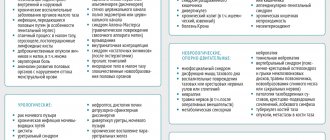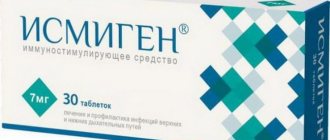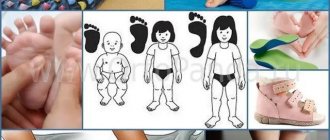Symptoms of rickets in infants - information for parents
Rickets is a multi-metabolic disease characterized by vitamin D deficiency. Most often, the disease is diagnosed in children under three years of age.
Signs of rickets in children under 1 year of age are muscle hypotonia, curvature of tubular bones, flattening of the back of the head, deformation of the chest. Doctors include prematurity, high weight of the newborn, multiple pregnancies, gastrointestinal disorders in the baby and heredity as risk factors. Causes of childhood rickets:
- improper feeding (insufficient intake of phosphorus and calcium from food);
- artificial feeding;
- increased level of need for minerals during the period of intensive growth of the child’s body;
- disruption of the transport of calcium and phosphorus in the body;
- endo- and exogenous vitamin D deficiency;
- endocrinological diseases;
- diseases of the gastrointestinal tract;
- genetic predisposition.
It has been proven that boys are more susceptible to rickets than girls.
Prevention of rickets
The expectant mother should think about the possibility that a child may develop rickets during pregnancy. Consequently, prevention of rickets begins during fetal development. A pregnant woman should have a balanced diet. Every day you need to eat vegetables, meat, and dairy products. For a pregnant woman, the correct daily routine, gymnastics, and treatment of toxicosis and anemia are important. Throughout the entire period of bearing a child, it is necessary to take vitamin complexes, which are selected by the doctor. The expectant mother must do everything to ensure that the fetus develops harmoniously.
A young mother needs to continue to take vitamins, but they can only be chosen after consulting a doctor. It is very important that, at least until six months of age, the child receives breast milk, since the microelements it contains are well absorbed. Natural feeding fully satisfies the child’s need for microelements and vitamins. Sometimes, if necessary, the pediatrician can prescribe multivitamins directly to the baby.
When the time comes for complementary feeding, as new foods are introduced, the child should periodically be given dishes with foods that contain large amounts of vitamin D. These are eggs, fish, butter, and green vegetables. From about 7 months, the child can be given cottage cheese and meat. After a month, you can gradually introduce fish into your diet. It is especially important to ensure the supply of sufficient amounts of vitamin D and microelements to children who are bottle-fed and mixed-fed. You should be very careful when selecting formulas for feeding. It is important that they contain a sufficient and balanced amount of calcium, phosphorus and vitamin D. With the right approach to prevention, the disease can be avoided.
Degree of development of rickets disease
In terms of severity, the disease can be of the first (mild) degree, second (moderate) and third (severe).
The first degree is asymptomatic. The second is characterized by minor changes in the skeletal system and internal organs. The third is characterized by damage to the nervous system, developmental delays both physical and mental, as well as numerous deformations in the bones and spine.
There are acute, subacute and recurrent course of rickets.
The acute course of rickets is characterized by neurological symptoms and the phenomena of osteomalacia (bone pain, muscle hypotonia, malnutrition, deformation of skeletal bones and pathological fractures).
The subacute course is accompanied by osteoid hyperplasia (proliferation of osteoid tissue). The pathology is manifested by thickening of the wrist, parietal and frontal tubercles, “rachitic rosary”, thickening of the interphalangeal joints on the fingers.
The recurrent degree of development of the disease rickets is characterized by alternating periods of exacerbation and remission with the preservation of residual effects.
Clinical variants of the disease: phosphopenic, calciumpenic and rickets without particularly pronounced changes in calcium and phosphorus levels.
In addition to primary rickets, pediatricians distinguish secondary rickets, which develops against the background of metabolic pathologies, chronic diseases of the kidneys and biliary tract, as well as with long-term use of anticonvulsants.
On our website Dobrobut.com you will find more information about which vitamin deficiency provokes rickets in humans, and you can make an appointment with a pediatrician. If necessary, the center can undergo complete diagnostics, including laboratory tests.
Causes of the disease
Vitamin D enters the baby’s body in two ways:
- It is synthesized in the skin under the influence of sunlight (ultraviolet radiation). Further biotransformation takes place in the liver and kidneys.
- With food. In this regard, artificial formula is more nutritious than breastfeeding.
Lack of sunlight and poor nutrition (including mothers) are the main reasons for the development of rickets in infants.
The following factors may increase the risk of developing the disease:
- not getting enough sunbathing;
- high birth weight;
- prematurity;
- refusal of breastfeeding and use of unbalanced formulas;
- rapid weight gain;
- digestive disorders;
- congenital diseases of the liver, kidneys, and endocrine system;
- taking anticonvulsants;
- low physical activity;
- hereditary metabolic disorders.
Symptoms of rickets in infants
The first signs that may appear as early as the third or fourth month after birth, pediatricians include constipation, baldness of the back of the head, shuddering, unreasonable crying, anxiety, and increased sweating. Early diagnosis and proper treatment guarantees a complete cure for the baby.
Secondary symptoms of rickets in infants:
- increasing muscle weakness;
- a clear lag in motor development (the baby does not hold his head well, cannot roll over and sit up on his own without assistance);
- late teething;
- deformation of the bones of the torso, skull and spine;
- large forehead, flat back of the head, X-shaped deformation of the legs;
- "frog" belly;
- disorders of internal organs.
With qualified treatment of rickets in children, improvements occur within 2-3 months. However, formed bone deformations, as a rule, do not disappear completely. Some (large forehead, flattened back of the head, deformed chest) remain for life.
General information
Rickets is a disease that primarily develops in humans during childhood and infancy.
This disease has been known to mankind for a very long time. Thus, references to this disease were found in the manuscripts of ancient physicians. For the first time, clear symptoms of rickets were described in the seventeenth century in England. By the way, English doctors called this disease “fog disease”, since rickets most often manifested itself in the children of working people who constantly lived in the smog caused by smoking factories. But still, the real cause of this disease was determined only in the 1980s.
The term "rickets" comes from the Greek word for "spine". This disease is relatively common among children. With rickets, bone formation is impaired. This occurs due to a deficiency of calcium-phosphorus metabolism . Signs of rickets are found in children all over the world. However, rickets most often develops in infants in northern countries, where there is very little sunlight. Some modern scientists claim that more than half of children suffer from rickets of varying severity. More often, this disease is diagnosed in infants born in autumn and winter.
In countries where medicine is well developed, this disease is strictly prevented, and children receive adequate treatment as soon as the first signs of rickets appear. However, after an X-ray examination, hidden signs of rickets may be revealed in children, which are difficult to notice during examination or in photographs.
If a person suffered rickets in infancy, the consequences of the disease remain for life. A person who has recovered from rickets remains with poor posture , flat feet , deformation of the pelvic bones , and myopia . caries , also develop in adulthood . But if a person had only a mild degree of rickets in childhood, then such consequences are not observed.
Diagnostics
The diagnosis is made after a thorough examination of the baby and obtaining the results of additional examination (laboratory tests, ultrasound, densitometry and CT scan of tubular bones and x-ray). The latter is rarely used.
Laboratory tests: blood test for electrolytes, test for alkaline phosphatase activity, and test for vitamin D metabolites.
It is important to carry out a differential diagnosis of rickets with hydrocephalus, cerebral palsy, rickets-like diseases and congenital hip dislocation.
List of sources
- Novikov, P.V. Modern rickets (classification, methods of diagnosis, treatment and prevention): lecture for doctors, 2nd. – edition, Moscow, 2011;
- Pediatrics: national guide: In 2 vols. - M.: GEOTAR-Media, 2009. - T.1;
- Strukov V.I. Rickets and osteoporosis. - Penza, 2004;
- Novikov P.V. Rickets and hereditary rickets-like diseases in children. - M.: Triada-X, 2006;
- Korovina N.A. Phosphorus-calcium metabolism disorders in children (problems and solutions): a guide for doctors / N.A. Korovina, I.N. Zakharova, A.V. Cheburkin. - Moscow, 2005.
Clinical manifestations
Due to insufficient mineral metabolism, the development of bone tissue is disrupted. In addition, other systems also suffer: nervous, endocrine, muscular, etc.
Pathology has stages, its manifestations can vary greatly in intensity.
Stages of rickets in infants:
- initial stage;
- height;
- recovery (convalescence);
- residual effects.
The severity of rickets is determined by the severity of symptoms.
It is important to recognize rickets when the first symptoms appear. These include:
- thickenings on the ribs at the transition points between bone tissue and cartilaginous tissue - “rachitic rosary” (see photo);
- increased sweating;
- the baby is restless, there may be twitching of legs and arms during sleep;
- the edges of the large and small fontanelles soften;
- sweat and urine acquire a peculiar sourish odor.
The very first manifestations may occur at 2–3 months of life.
Damage to the skeletal system
The specificity of rickets is such that the bone apparatus undergoes the greatest changes. Even if there is a sufficient amount of calcium and phosphorus in the diet, if there is a lack of vitamin D, they will not be absorbed normally.
Damage to the skeletal system is manifested in the following:
- the edges of the fontanel and the sutures of the bones of the skull soften;
- the shape of the skull changes, it is sloping in the occipital region;
- the frontal and parietal regions protrude;
- fontanelles do not close for a long time;
- deformation of the chest is noted: “cobbler’s chest” - depression in the lower part of the sternum or “keeled (chicken)” chest - protrusion of the sternum;
- bone growths—“rosary beads”—appear on the ribs;
- rachitic kyphosis (curvature of the spine) develops;
- on the legs and hands, thickenings appear on the epiphyses of long bones - “rachitic bracelets”, on the phalanges of the fingers - “strings of pearls”;
If you ignore the problem and do not treat rickets, the symptoms will increase. There is a change in the pelvic bones, it flattens and decreases in size. The bones of the legs are curved in an O-shape or X-shape. Flat feet appear.
Teeth appear late, they are susceptible to caries, and the bite is disturbed.
Defeat of other systems
Calcium deficiency inevitably affects other systems of the baby.
The muscles and central nervous system suffer the most.
The muscles become flabby and lose tone. The tendons are not strong, the joints become loose. When a child sits down, he prefers to cross his legs and support his torso with his arms. The rectus abdominis muscles are hypotonic, can diverge, and a characteristic “frog belly” appears.
Neurological changes affect almost everything. Behavior changes, tearfulness and anxiety increase. Sweating of the skin increases, especially at the point of contact of the scalp with the pillow. Increased skin sensitivity (hyperesthesia). The baby begins to cry and be capricious when touched, although this has not been noticed before.
Doctor's advice
Walking is very important for a baby, especially under the age of one year. 20 minutes of exposure to the sun (not at noon, so as not to get sunburned, but in the morning or evening) will significantly increase the level of vitamin D. You must remember that the sun's rays penetrate through fabrics, clothes, and clouds, so you should not expose your child to the scorching sun for a long time, It is enough for him to sleep in the stroller outside even in cloudy weather.
Victoria Druzhikina Neurologist, Therapist
Deep progression of the pathology leads to general lethargy, lethargy, and apathy. Conditioned reflexes are poorly formed in sick children.
Rickets of our time: modern diagnosis and treatment
Journal "Medical Council" No. 18/2020
DOI:
10.21518/2079-701X-2020-18-14-20
E.A. Pigarova
, ORCID: 0000-0001-6539-466X
National Medical Research Center for Endocrinology; 117036, Russia, Moscow, st. Dmitry Ulyanov, 11
Rickets is a disease that has been known to mankind for several centuries. Its overcoming as a public health problem was a triumph of science and public policy in the 20th century, but within a few decades rickets made a dramatic comeback as a result of cultural, environmental, and political factors. Vitamin D plays a fundamental role in the regulation of calcium and phosphorus homeostasis and, consequently, in the development of rickets. In addition to these classic skeletal effects, recent studies have shown that vitamin D has other significant extracellular effects that may complicate the disease and have long-term consequences for the health of children. In children, adequate vitamin D levels are defined as 25(OH)D concentrations greater than 30 ng/ml, insufficiency—21–30 ng/ml, and deficiency—less than 20 ng/ml. The upper limit of the reference interval is 100 nmol/L because levels above may be associated with vitamin D toxicity in children. Measuring serum 1,25(OH)2D levels to assess vitamin D status is not recommended. Natural sources of vitamin D are very limited, so its use in the form of dietary supplements is the main means of preventing and treating rickets. The recommended drug for the prevention and treatment of vitamin D deficiency is colecalciferol (D3). All children aged 1 to 6 months. Regardless of the type of feeding or season of the year, in order to prevent vitamin D deficiency, colecalciferol is recommended at a dose of 1000 IU/day. This article presents modern ways of preventing, diagnosing and treating rickets.
For quotation:
Pigarova E.A. Rickets of our time: modern diagnosis and treatment. Medical advice. 2020;(18):14-20. https://doi.org/10.21518/2079-701X-2020-18-14-20
Conflict of interest:
The authors declare no conflict of interest.
Rickets of our time: modern diagnosis and treatment
Ekaterina A. Pigarova,
ORCID: 0000-0001-6539-466X
National Medical Research Center for Endocrinology, 11, Dmitry Ulyanov St., Moscow, 117036, Russia
Rickets is a disease that has been known to mankind for several decades. Overcoming this public health problem was a triumph of science and public policy in the 20th century, but over the course of several decades rickets sharply returned as a result of cultural, environmental and political factors. Vitamin D plays a fundamental role in the regulation of calcium and phosphorus homeostasis, and, consequently, in the development of rickets. In addition to these classic skeletal effects, recent studies have shown that vitamin D has other significant extracellular effects that can complicate the course of the disease and have long-term effects on children's health. Vitamin D sufficiency in children has been defined as serum 25(OH) D levels of over 30 ng/ml, insufficiency as 21-30 ng/ml, deficiency as less than 20 ng/ml. The upper limit of the reference range is 100 nmol/L, as levels above may be associated with vitamin D toxicity in children. Serum 1.25(OH)2D should not be used for the assessment of vitamin D status. Natural sources of vitamin D are very limited, therefore, its use in the form of nutritional supplements is the primary mean of preventing and treating rickets. The recommended drug for the prevention and treatment of vitamin D deficiency is colecalciferol (D3). The recommended drug for the prevention and treatment of vitamin D deficiency is cholecalciferol (D3). Colecalciferol is recommended to be given at a dose of 1000 IU/day to all children aged 1 to 6 months regardless of the type of feeding or the season of the year to prevent vitamin D deficiency. This article presents modern ways of preventing, diagnosing and treating rickets.
For citation:
Pigarova EA Rickets of our time: modern diagnosis and treatment. Meditsinskiy sovet = Medical Council. 2020;(18):14-20. (In Russ.) https://doi.org/10.21518/2079-701X-2020-18-14-20
Conflict of interest:
the authors declare no conflict of interest.
INTRODUCTION
Rickets was described in the 1st century. AD physician Soranus of Ephesus. The image of a baby suffering from rickets in a 1509 painting by the artist Hans Burgkmeyer and the discovery of manifestations of the disease in the skeleton of a child from the influential Medici family in the 16th century. in Italy suggest that rickets has existed for many centuries, especially in weak children who spent a lot of time indoors [1]. Initially, rickets was nicknamed the “English disease”, where it was widespread [2]. In the 17th century The first detailed descriptions of the disease were given by English doctors Daniel Whistler and Francis Glisson [3]. Rickets became most widespread during the First World War in Europe.
In 1919, Edward Mellan discovered that cod liver oil was a remedy against rickets. German pediatrician Kurt Guldchinsky demonstrated the healing properties of ultraviolet rays on the skin. Prevention of rickets with fish oil, food fortification, and the use of vitamin D supplements made it possible to almost completely eliminate rickets by the mid-twentieth century. [3].
Overcoming this public health challenge has been a triumph of science and public policy. It is therefore puzzling that rickets has made a dramatic comeback within a few decades as a result of cultural, environmental and political factors [4].
CLINIC
Most clinical manifestations in children with rickets are due to the effect of vitamin D deficiency on the mineralization process of growing bones or on calcium homeostasis. D. Fraser et al. [5] described three stages of progression of vitamin D deficiency. Stage I is characterized by hypocalcemia with clinical signs associated with the presence of hypocalcemia, in stage II impaired bone mineralization becomes apparent, and in stage III there are signs of both hypocalcemia and severe rickets. This separation of the progression of rickets and vitamin D deficiency is conceptually useful, but there is considerable clinical overlap between the different stages.
Characteristic clinical manifestations of rickets are bone complications of the disease, which are mandatory for diagnosis:
- protrusion of the frontal tuberosities,
- craniotabes (softening of the skull bones, usually detected by palpation of the frontal sutures in the first 3 months of life),
- swelling in the area of the wrist and ankle joints,
- late closure of the large fontanel (normally closes by 2 years),
- delayed teething (absence of incisors by 10 months, absence of molars by 18 months),
- deformities of the lower extremities (O-shaped/X-shaped/Z-shaped curvature of the legs),
- rachitic rosary (enlargement of the costosternal joints: felt upon palpation along the anterior surface of the chest, lateral to the nipple line),
- bone pain,
- widening, flattening or concavity, saucer deformation, surface roughness and trabecularity of the metaphyses,
- expansion of growth zones,
- pelvic deformations, including narrowing of the pelvic outlet (risk of pathological birth and death),
- pathological fractures.
In severe forms of rickets, hypocalcemic convulsions and tetany, hypocalcemic dilated cardiomyopathy (heart failure, cardiac arrhythmias, cardiac arrest, death) may occur. Patients may also experience delayed weight gain and height, delayed development of motor skills and muscle hypotonia, increased intracranial pressure, anxiety and irritability. Identification solely of symptoms of dysfunction of the autonomic nervous system (sweating, anxiety, irritability) is currently not the basis for making a diagnosis, which was previously accepted [6].
NON-BONEY COMPLICATIONS OF RICKETS
Hypotension, decreased motor activity, and a bulging abdomen are characteristic of progressive vitamin D deficiency rickets in infants and young children. These findings are likely similar to the proximal muscle weakness described in adolescents with vitamin D deficiency and in adults [7]. In this situation, deep tendon reflexes are preserved and may be animated. The pathogenesis of myopathy is believed to be primarily due to vitamin D deficiency rather than hypophosphatemia [8].
Dilated cardiomyopathy and heart failure have also been described in young children with vitamin D deficiency as one of the most serious complications of rickets [9]. The onset of this complication can be detected in infants aged 3 weeks. up to 12 months In this case, dilated cardiomyopathy may be the first established diagnosis, especially in early infancy, due to the lack of expression of characteristic bone pathology [10]. If a holistic approach to the evaluation and management of these children is not adopted, then either of these two pathologies may be missed when presenting simultaneously. It is assumed that this complication is due to the effect of hypocalcemia on the function of the heart muscle, and not the direct effect of hypovitaminosis D [11].
Delayed tooth eruption is a feature of rickets in a young child, and tooth enamel hypoplasia may occur if rickets develops before enamel formation is complete. The latter was noted during primary teething in children born to mothers with vitamin D deficiency, and during secondary teething in children who suffered from rickets in early childhood [2].
Abnormalities likely associated with rickets are anemia, thrombocytopenia, leukocytosis, myelocytosis, erythroblastosis, and myelofibrosis [12]. Von Jaxsch-Lusette syndrome, involving myeloid metaplasia and hepatosplenomegaly [13], has also been described in young children with rickets. Although the exact pathogenetic mechanisms of this syndrome are unclear, the connection with vitamin D deficiency is obvious, since vitamin D therapy cures this condition. Also, using experimental data, it was shown that 1,25(OH)2D has antiproliferative activity in a myeloid leukemia cell line [14].
IMMUNE COMPLICATIONS OF RICKETS
Infants and young children with rickets are prone to an increase in the number and severity of various infections, especially such as acute respiratory viral infections and influenza [15, 16]. The increase in respiratory infections may be explained by chest wall abnormalities (softening of the ribs, enlarged costochondral junctions, and decreased respiratory movements due to muscle weakness), but various studies have shown a direct role for vitamin D in modulating immune function [16, 17]. Impaired phagocytosis and neutrophil motility have been described in children with rickets and vitamin D deficiency [18]. The lack of cathelicidin production following activation of toll-like receptors may play a role in the susceptibility of vitamin D-deficient subjects to Mycobacterium tuberculosis infection [19]. There is growing evidence that vitamin D may play an important role in modifying the risk of developing various autoimmune diseases, such as type 1 diabetes mellitus, multiple sclerosis and rheumatoid arthritis, etc. [20–22].
PHYSIOLOGY OF VITAMIN D
The term "vitamin D" is used to refer to two different forms found in nature: vitamin D3 (colecalciferol) from animal sources and vitamin D2 (ergocalciferol) from plants. Humans synthesize vitamin D3 in their skin in response to exposure to sunlight, and vitamins D2 and D3 can be obtained from dietary sources. Very few foods contain significant amounts of vitamin D, so the dietary contribution to the total amount of the vitamin in the body can be considered negligible [23–25]. Previtamin D3, or 7-dehydrocholesterol, is produced in the skin after exposure to ultraviolet B light with a wavelength of 290 to 315 nm, mainly in the epidermis. 7-dehydrocholesterol is an unstable molecule, so it is subsequently quickly converted into vitamin D3. Once previtamin D3 is synthesized in the skin, it can also be photoconverted to lumisterol and tachisterol, which are inactive in calcium metabolism, which are formed during prolonged exposure to solar ultraviolet radiation to prevent sun-induced vitamin D toxicity [23]. Vitamin D2 and D3 are transported by vitamin D binding protein to the liver, where they are hydroxylated at position 25 by 25-hydroxylase (CYP2R1) to form 25-hydroxyvitamin D [25(OH)D], the major circulating metabolite of vitamin D that is used to assess individual vitamin D status. In the kidney, 25(OH)D undergoes further hydroxylation by 1α-hydroxylase (CYP27B1) to 1,25-dihydroxyvitamin D [1,25(OH)2D or calcitriol], the biologically active hormonal form of vitamin D [23].
Calcitriol is able to regulate the balance of calcium and phosphorus in various ways, primarily by stimulating the absorption of calcium and phosphorus by intestinal cells. Calcitriol acts synergistically with parathyroid hormone (PTH), which in bone tissue stimulates the mineralization of osteoid (the organic matrix of bone tissue) under the control of osteoclasts, and in the kidneys, where it promotes the reuptake of calcium in the tubules, the excretion of phosphorus and the conversion of vitamin D to its active hormonal form [24].
FEATURES OF VITAMIN D METABOLISM IN CHILDREN
The hallmark of vitamin D deficiency is low circulating levels of 25(OH)D. In healthy children, a range of ~20–50 ng/mL has been found in most studies conducted in communities in which vitamin D deficiency rickets is rare [26]. However, the development of rickets depends both on the amount of vitamin D and calcium in the diet, time of sun exposure, and on the duration and severity of low concentrations of 25(OH)D, the ability of the kidneys to produce adequate concentrations of 1,25(OH)2D in conditions of decreased substrate content, and the gastrointestinal tract - to maintain calcium absorption at a level that meets the needs of a growing child. In children with 25(OH)D concentrations within the normal reference range, there is no correlation between serum 25(OH)D and 1,25(OH)2D concentrations. However, once 25(OH)D levels fall below ~12 ng/mL, such a correlation occurs, reflecting the limited ability to maintain active metabolite levels at extremely low vitamin D levels [26].
In children, adequate vitamin D levels are defined as 25(OH)D concentrations greater than 30 ng/ml, insufficiency—21–30 ng/ml, and deficiency—less than 20 ng/ml. The upper limit of the reference interval is 100 nmol/L because levels above may be associated with vitamin D toxicity in children. Measuring serum 1,25(OH)2D levels to assess vitamin D status is not recommended [6, 23].
Severe vitamin D deficiency is defined by several authors and societies as 25(OH)D levels < 10 ng/mL because the risk of rickets is extremely high, even with adequate calcium intake [23]. The prevalence of rickets is also significant, with 25(OH)D levels of 10–20 ng/mL in cases of low calcium intake [23, 26]. Secondary hyperparathyroidism typically develops at 25(OH)D levels <20 ng/mL, and PTH levels reach a plateau at 25(OH)D concentrations of 30–40 ng/mL [27, 28]. However, it has been shown that the relationship between PTH and 25(OH)D levels may be influenced by many factors, such as age, sex, ethnicity, and weight, making assessment of this relationship in pediatric patients even more challenging. A study of 1,370 Canadian children aged 1–6 years found a PTH plateau at 25(OH)D levels > 42.8 ng/mL, while an Italian study of children and adolescents reported a lower prevalence of secondary hyperparathyroidism in the 25(OH)D concentration range. OH)D 20–29 ng/ml, but no cases of secondary hyperparathyroidism with vitamin D levels above 30 ng/ml were found [26].
Premature infants are even more at risk of impaired calcium and phosphorus metabolism, with the possible development of osteopenia of prematurity. Because much of the accumulation of calcium, phosphate, and fetal bone mineralization occurs in the third trimester of pregnancy, premature infants are deprived of physiological transplacental mineral nutrition with subsequent impaired bone mineralization and an increased risk of fractures. Children with very low birth weight (birth weight < 1500 g) are at significant risk of osteopenia due to the frequent use of medications that negatively affect bone mineralization (steroids, etc.), the condition of the gastrointestinal tract with impaired secretion of digestive juices, including those with insufficient bile formation [26].
BIOCHEMICAL DIAGNOSTICS OF VITAMIN D DEFICIENCY AND RICKETS
Routine screening of 25(OH)D levels in children is not recommended, except in children at risk or in children with growth retardation. The risk group includes children with chronic kidney disease, liver and biliary tract diseases, children who often suffer from malabsorption syndrome (gastrointestinal form of food allergy, celiac disease, exudative enteropathy, inflammatory bowel disease, etc.) and taking anticonvulsants. As well as children with underlying conditions: prematurity, intrauterine malnutrition, multiple pregnancies, family history of disorders of phosphorus-calcium metabolism, insufficient insolation, diseases of the epidermis, dark skin. In addition, routine screening of 25(OH)D levels is recommended for children with severe motor delay or unusual irritability, as well as elevated serum alkaline phosphatase (ALP) levels (> 500 IU/L in newborns or > 1000 IU/L in children under 9 years of age). years) [6, 27]. A biochemical blood test for alimentary rickets can also reveal a decrease in PTH, phosphorus and calcium in the blood serum, a decrease in calcium and an increase in phosphorus in the urine.
Markers of bone turnover in rickets usually increase in response to the development of secondary hyperparathyroidism. Increases in bone resorption markers in the blood/urine may be within normal limits in stage I rickets, but are elevated in patients with radiologically confirmed rickets [26]. Similarly, serum alkaline phosphatase values, a marker of bone formation, may be normal in stage I vitamin D deficiency but increase with the severity of radiological changes. Markers of bone turnover, especially those reflecting bone resorption, increase in the first 2–3 weeks. treatment, and then gradually decrease to normal values over 4–6 weeks. [29]. Of all the available biochemical parameters that may be altered in rickets, alkaline phosphatase has been the most frequently used as a screening test. But despite the fact that this indicator is elevated in the vast majority of children with radiological changes, it lacks specificity [26, 29].
PREVENTION AND CORRECTION OF VITAMIN D DEFICIENCY/INSUFFICIENCY
Preventive measures to prevent vitamin D deficiency can be divided into primary and secondary. Primary goals include the prevention of vitamin deficiency in the mother during pregnancy, because vitamin D levels in the blood of a newborn are ~80% of maternal levels [30]. Secondary prevention includes prescribing vitamin D supplements to the child after birth. Despite global agreement among all world communities, including the World Health Organization, on the need for vitamin D supplementation in the first year of life, there are still a number of barriers to adherence to treatment, such as mothers' reluctance to give their children vitamin D supplements daily, lack of knowledge about the effects of vitamin D and the risks of dietary deficiency, lack of awareness among health care workers, and the assumption that both breast milk and formula provide adequate vitamin D intake [26].
According to the National program “Vitamin D deficiency in children and adolescents of the Russian Federation: modern approaches to correction” of the Union of Pediatricians of Russia [6], the recommended drug for the prevention and treatment of vitamin D deficiency is colecalciferol (D3). All children aged 1 to 6 months. Regardless of the type of feeding or season of the year, in order to prevent vitamin D deficiency, colecalciferol is recommended at a dose of 1000 IU/day (Table 1), for children aged 6 to 12 months. – at a dose of 1000 IU/day. At the age of 1–3 years, it is recommended to take 1500 IU/day, over 3 years – 1000 IU/day. In this case, the dose can be recalculated taking into account the consumed foods with vitamin D supplements. Preventive doses for the European North of Russia are higher by 500 IU/day for children over 6 months. Taking colecalciferol drugs in prophylactic dosages is recommended constantly and continuously, including the summer months [6]. Dosing of drugs can be carried out in different units, so it is necessary to remember the method for converting the dose of colecalciferol 1 mcg => 40 IU.
Table 1. The doses of cholecalciferol recommended for preventing hypovitaminosis D and rickets
| Age | Prophylactic dose | Prophylactic dose for the European North of Russia |
| 1–6 months | 1000 IU/day* | 1000 IU/day* |
| From 6 to 12 months. | 1000 IU/day* | 1500 IU/day* |
| From 1 year to 3 years | 1500 IU/day | 1500 IU/day* |
| From 3 to 18 years | 1000 IU/day | 1500 IU/day* |
* There is no need to recalculate the dose for children on mixed or artificial feeding.
For the treatment of vitamin D deficiency/insufficiency and rickets, the recommended drug is colecalciferol (D3). If rickets is suspected or the presence of risk factors for vitamin D deficiency, it is recommended to determine the initial concentration of 25(OH)D and then differentiate the dose of colecalciferol using the proposed scheme presented in Table. 2. Without monitoring the level of vitamin D in the blood or medical supervision, it is not recommended to prescribe vitamin D doses of more than 4000 IU/day for a long period to children under 7 years of age [6, 27]. Along with the correction of vitamin D, it is necessary to ensure the intake of calcium into the body, which is necessary for the effect of vitamin D (Fig.), at a dose of about 15 mg/kg of body weight per day. An increase in 25(OH)D levels to 80–100 ng/ml is not considered an overdose, but still requires a reduction in the dose of colecalciferol. Manifestations of a possible overdose of colecalciferol can be monitored by the level of the vitamin itself in the blood, the level of total calcium corrected for albumin, as well as the level of calcium in daily urine (no more than 2 mg/kg/day). The Sulkovich reaction has no diagnostic value, and therefore its use in practice is not recommended.
Table 2. The doses of cholecalciferol recommended for treating hypovitaminosis D and rickets
| Blood 25(OH)D concentration | Treatment dose * | Therapeutic dose for the European North of Russia * |
| 20–30 ng/ml | 2000 IU/day – 1 month. | 2000 IU/day – 1 month. |
| 10–20 ng/ml | 3000 IU/day – 1 month. | 3000 IU/day – 1 month. |
| Less than 10 ng/ml | 4000 IU/day – 1 month. | 4000 IU/day – 1 month. |
* After completion of the course of treatment, a blood test is performed for 25(OH)D, at a level of less than 30 ng/ml, the therapeutic dosage is continued depending on the level for 15 days, at a level of 30 ng/ml and above, the dose of vitamin D is reduced to a preventive dose in accordance with age, which is prescribed for a long time, continuously.
Preparations containing colecalciferol (D3) are available in various pharmaceutical forms (aqueous and oily solution, capsules, tablets) and dosages. A representative of colecalferol in the form of an aqueous solution is the drug Complivit® Aqua D3 with a dropper dispenser. Complivit® Aqua D3 is approved for children from 4 weeks. life and is one of the most affordable vitamin D preparations on the Russian market. 1 drop of Complivit® Aqua D3 contains about 500 IU of colecalciferol. A special technology for its production allows fat-soluble vitamin D to be converted into a micellar (water-soluble) form, where the hydrophobic ends of the molecule are oriented inward, toward the vitamin, and the hydrophilic ends are oriented outward. The micellar form is ready for absorption in the small intestine, regardless of the state of the gastrointestinal tract, which can be observed with insufficient bile formation (for example, in premature infants) [6, 31].
Drawing.
Graphical representation of the synergistic effects of low dietary calcium and vitamin D on the development of rickets
Figure
. A graphical representation of the synergistic effects of low dietary calcium and vitamin D levels on ricket development
CONCLUSION
Vitamin D plays a fundamental role in the regulation of calcium and phosphorus homeostasis and, in particular, pathways involved in bone mineralization and bone mass accumulation. In addition to these classic skeletal effects, recent studies have shown that vitamin D has other significant extracellular effects that may complicate rickets. Natural sources of vitamin D are very limited, so its use in the form of dietary supplements is the main means of preventing and treating rickets.
List of literature / References
- Bivins R. Ideology and disease identity: the politics of rickets, 1929-1982. Med Humanit. 2014;40(1):3-10. https://doi.org/10.1136/medhum-2013-010400.
- Pigarova E.A., Povalyaeva A.A., Dzeranova L.K., Rozhinskaya L.Ya. The role of vitamin D for the prevention and treatment of rickets in children. Pediatrics. Consilium Medicum. 2019;(3):40-45. https://doi.org/10.26442/26586630.2019.3.190582.
- Zhang M., Shen F., Petryk A., Tang J., Chen X., Sergi C. “English Disease”: Historical Notes on Rickets, the Bone-Lung Link and Child Neglect Issues. Nutrients. 2016;8(11):722. https://doi.org/10.3390/nu8110722.
- Pettifor JM Nutritional rickets: deficiency of vitamin D, calcium, or both? Am J Clin Nutr. 2004;80(6):1725S-17299S. https://doi.org/10.1093/ajcn/80.6.1725S.
- Fraser D., Kooh SW, Scriver CR Hyperparathyroidism as the cause of hyperaminoaciduria and phosphaturia in human vitamin D deficiency. Pediatric Res. 1967;1:425-435. https://doi.org/10.1203/00006450-196711000-00001.
- Zakharova I.N., Borovik T.E., Vakhlova I.V., Gorelov A.V., Gumenyuk O.I., Gusev E.I. and others. National program “Vitamin D deficiency in children and adolescents of the Russian Federation: modern approaches to correction.” M.: Pediatr; 2021. 96 p. Access mode: https://elibrary.ru/item.asp?id=34881251.
- Girgis CM, Clifton-Bligh RJ, Turner N., Lau SL, Gunton JE Effects of vitamin D in skeletal muscle: falls, strength, athletic performance and insulin sensitivity. Clin Endocrinol. 2014;80(2):169-181. https://doi.org/10.1111/cen.12368.
- Glerup H., Mikkelsen K., Poulsen L., Hass E., Overbeck S., Andersen H. et al. Hypovitaminosis D myopathy without biochemical signs of osteomalacic bone involvement. Calcif Tissue Int. 2000;66:419-424. https://doi.org/10.1007/s002230010085.
- Yilmaz O., Olgun H., Ciftel M., Kilic O., Kartal I., Iskenderoglu NY et al. Dilated cardiomyopathy secondary to rickets-related hypocalcaemia: eight case reports and a review of the literature. Cardiol Young. 2015;25(2):261-266. https://doi.org/10.1017/S1047951113002023.
- Elidrissy ATH, Alharbi KM, Mufid M., AlMezeni I. Rachitic hypocalcemic cardiomyopathy in an infants. J Saudi Heart Assoc. 2017;29(2):143-147. https://doi.org/10.1016/j.jsha.2016.05.001.
- Uysal S., Kalayci AG, Baysal K. Cardiac functions in children with vitamin D deficiency rickets. Pediatric Cardiol. 1999;20:283-286. https://doi.org/10.1007/s002469900464.
- Venkatnarayan K., Gupta A., Adhikari KM Reversible myelofibrosis due to severe Vitamin D deficiency rickets. Med J Armed Forces India. 2018;74(4):404-406. https://doi.org/10.1016/j.mjafi.2017.08.004.
- Gruner BA, DeNapoli TS, Elshihabi S, Britton HA, Langevin A-M, Thomas PJ et al. Anemia and hepatosplenomegaly as presenting features in a child with rickets and secondary myelofibrosis. J Pediatr Hematol Oncol. 2003;25(10):813-835. https://doi.org/10.1097/00043426-200310000-00015.
- Suda T. The role of 1 alpha,25-dihydroxyvitamin D3 in the myeloid cell differentiation. Proc Soc Exp Biol Med. 1989;191(3):214-220. https://doi.org/10.3181/00379727-191-42911.
- Walker VP, Modlin RL The vitamin D connection to pediatric infections and immune function. Pediatric Res. 2009;65:106-113. https://doi.org/10.1203/PDR.0b013e31819dba91.
- Pigarova E.A., Pleshcheva A.V., Dzeranova L.K. The effect of vitamin D on the immune system. Immunology. 2015;36(1):62-66. Access mode: https://cyberleninka.ru/article/n/vliyanie-vitamina-d-na-immunnuyusistemu/viewer.
- Vanherwegen A.-S., Gysemans C., Mathieu C. Regulation of Immune Function by Vitamin D and Its Use in Diseases of Immunity. Endocrinol Metab Clin North Am. 2017;46(4):1061-1094. https://doi.org/10.1016/j.ecl.2017.07.010.
- Prietl B., Treiber G., Pieber TR, Amrein K. Vitamin D and immune function. Nutrients. 2013;5(7):2502-2521. https://doi.org/10.3390/nu5072502.
- Liu PT, Stenger S, Li H, Wenzel L, Tan BH, Krutzik SR et al. Toll-like receptor triggering of a vitamin D-mediated human antimicrobial response. Science. 2006;311(5768):1770-1773. https://doi.org/10.1126/science.1123933.
- Bartosik-Psujek H., Psujek M. Vitamin D as an immune modulator in multiple sclerosis. Neurol Neurochir Pol. 2019;53(2):113-122. https://doi.org/10.5603/PJNNS.a2019.0015.
- Lee Y. H., Bae S.-C. Vitamin D level in rheumatoid arthritis and its correlation with the disease activity: a meta-analysis. Clin Exp Rheumatol. 2016;34(5):827-833. Available at: https://pubmed.ncbi.nlm.nih.gov/27049238.
- Rak K., Bronkowska M. Immunomodulatory Effect of Vitamin D and Its Potential Role in the Prevention and Treatment of Type 1 Diabetes Mellitus-A Narrative Review. Molecules. 2019;24(1):53. https://doi.org/10.3390/molecules24010053.
- Pigarova E.A., Rozhinskaya L.Ya., Belaya Zh.E., Dzeranova L.K., Karonova T.L., Ilyin A.V. and others. Clinical recommendations of the Russian Association of Endocrinologists for the diagnosis, treatment and prevention of vitamin D deficiency in adults. Problems of endocrinology. 2016;62(4):60-84. https://doi.org/10.14341/probl201662460-84.
- Hossein-nezhad A., Holick MF Vitamin D for health: a global perspective. Mayo Clin Proc. 2013;88(7):720-755. https://doi.org/10.1016/j.mayocp.2013.05.011.
- Gröber U., Spitz J., Reichrath J., Kisters K., Holick MF Vitamin D. update 2013: from rickets prophylaxis to general preventive healthcare. Dermatoendocrinol. 2013;5(3):331-347. https://doi.org/10.4161/derm.26738.
- Feldman D., Pike JW, Bouillon R., Giovannucci E., Goltzman D., Hewison M. (eds.) Vitamin D. Volume 2: Health, Disease and Therapeutics. 4th ed. Imprint: Academic Press; 2021. 1266 p.
- Misra M., Pacaud D., Petryk A., Collett-Solberg PF, Kappy M. Vitamin D deficiency in children and its management: review of current knowledge and recommendations. Pediatrics. 2008;122(2):398-417. https://doi.org/10.1542/peds.2007-1894.
- Suplotova L.A., Avdeeva V.A., Pigarova E.A., Rozhinskaya L.Ya. Vitamin D cut-off point: a method for suppressing excess PTH secretion. Obesity and metabolism. 2019;16(3):88-93. Access mode: https://www.elibrary.ru/item.asp?id=41514150.
- Baroncelli GI, Bertelloni S., Ceccarelli C., Amato V., Saggese G. Bone turnover in children with vitamin D deficiency rickets before and during treatment. Acta Paediatr. 2000;89(5):513-518. https://doi.org/10.1111/j.1651-2227.2000.tb00329.x.
- Cooper C., Curtis EM, Moon RJ, Dennison EM, Harvey NC Chapter 40 — Consequences of perinatal vitamin D deficiency on later bone health. In: Vitamin D. 4th ed. Elsevier Inc.; 2021. Vol. 1, pp. 709-730. https://doi.org/10.1016/B978-0-12-809965-0.00040-9.
- Eremkina A.K., Mokrysheva N.G., Pigarova E.A., Mirnaya S.S. Vitamin D: influence on the course and outcomes of pregnancy, fetal development and child health in the postnatal period. Therapeutic archive. 2018;90(10):115-127. https://doi.org/10.26442/terarkh201890104-127.










